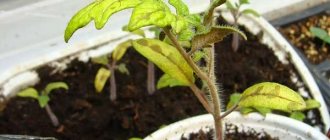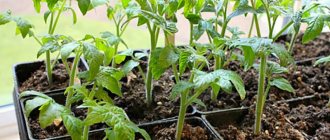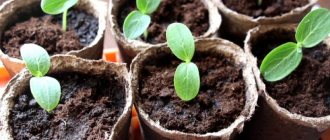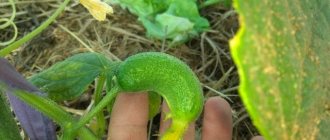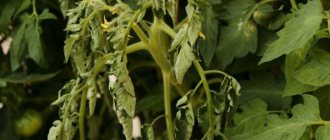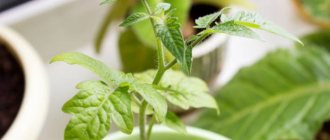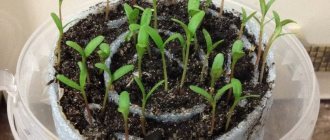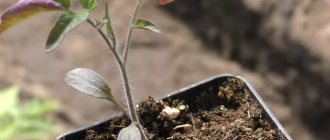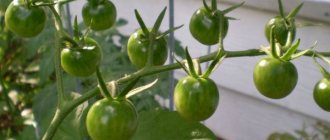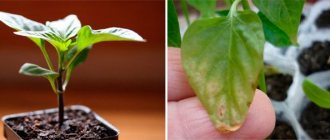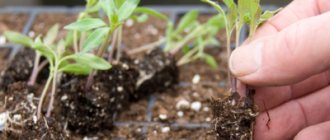Causes of wilting and poor growth of tomato seedlings. Methods of resuscitation. Preparations and recipes for feeding after picking.
Beginners and experienced gardeners are faced with a lot of nuances when growing seedlings at home. In addition to sowing, watering, care and feeding, each plant requires the attention and caring hands of a person.
During the period of intensive growth in open ground, tomatoes are resistant to changes in day and night temperatures and sunlight intensity. They are grateful for feeding and tying up the stems. However, from the moment of sowing tomato seeds to transplanting them into open ground, the gardener can expect weeks of caring for the young plants.
We are talking not only about picking, but also about treating diseases, organizing proper watering, temperature conditions, and light intensity. The main tasks are to preserve the seedlings, prevent them from withering, slowing growth and development. Let's talk more about this in the article.
Unsuitable soil
Tomatoes grown from seed at home or in a greenhouse wither due to an incorrectly selected soil mixture.
Acidic and dense soil entails:
- yellowing;
- falling off;
- drying of seedlings at the rhizome.
In addition to unsuitable soil, the reason may lie in the presence of pathogenic microorganisms or harmful beetles in it. This happens in the absence of preliminary disinfection. The procedure is carried out with a weak solution of potassium permanganate or hot water 90 degrees, calcination of the earth or freezing.
Selection of low-quality seeds
When purchasing tomato seeds, you need to read the instructions for planting them, namely, the conditions under which their growth will be favorable. Some seeds germinate exclusively in the dark, but in general, most tomato seed varieties love sunlight.
Attention! Any seeds must be disinfected with an aqueous solution of potassium permanganate before planting.
Advice! Always pay attention to the expiration date of seeds! Expired tomato seeds have a low germination rate.
Unsuitable place for growing seedlings
Containers with seedlings should not be placed under a window; tomatoes do not like drafts. There should be no cracks in the windows, otherwise the cold wind will blow through them. Gaps should be sealed beforehand or after planting if the seedlings begin to wilt.
It is necessary to place the container at a distance of 10 cm from the window glass. You can place a folded newspaper between the window sill and the box.
Lack of additional lighting
Tomato seedlings planted early (January - early March) need additional lighting.
Natural light (even if the seedlings are standing in the brightest window) is not enough for normal photosynthesis. Experiencing a lack of light, seedlings begin to:
- turn yellow;
- stretch out (stems lean towards the light);
- become sluggish and thin.
Additional lighting will help correct the situation. Fluorescent or phytolamps with a special spectrum of rays are installed above the seedling containers.
The distance from the lamps to the plants is 30-40 cm. The total daylight hours are at least 10 hours.
Mistakes when feeding tomatoes
Sometimes seedlings wither and get sick due to a lack of nutrients in the soil. This often happens when the soil is prepared independently. Feeding is extremely important, especially in the early stages of tomato development. Purchased soil contains many useful substances, but tomatoes quickly use them up.
You can feed vegetables correctly, but keep them in a cold room, which will negate the results of fertilizers. Excess fertilizing (especially nitrogen) can also lead to tomatoes falling off. The root may turn yellow or die due to burns.
Thickening of plantings
Dense sowing of tomato seeds has a detrimental effect on the development of seedlings. They interfere with each other, blocking the sun and preventing the absorption of nutrition from the soil.
Tomatoes in thickened plantings become thin and sluggish, they stretch upward. Such seedlings will eventually fall due to their thin, weak stems.
Recommended distance between tomato seedlings: 2-3 cm before picking, 4-5 cm after transplanting.
Watering errors
Tomato bushes may fall or wilt due to excessive watering or lack of moisture. The least harm is caused by short drying of seedlings. If they “hang their ears”, you need to water them, but carefully. Don't pour too much water. First, the soil is slightly moistened, then, after 2 hours, it is irrigated again. Usually tomatoes recover without consequences.
Excess moisture is fraught not only with withering, but also with rotting of the root system and black leg. If the overflow was accidental, you should immediately dust the soil with wood ash.
When tomato seedlings die after regular heavy irrigation, how to save them:
- remove the plants from the wet soil, clean the roots from it;
- prick the tomato bushes into new, slightly moistened soil;
- Using a tablespoon, carefully pour each bush with a weak solution of potassium permanganate;
- treat the leaves with Epin's solution.
If you spray the leaves too hard, the soil will appear moist. This is a dangerous phenomenon, since only the top layer is saturated with moisture. Tomato seedlings should be watered 2-4 cm deep.
From an overabundance of fertilizing, a whitish crust may appear on the surface of the earth, preventing normal irrigation. The top layer of damaged soil should be carefully removed. Subsequent watering should be done with a weak solution of Humate. The product acts as a light fertilizer and stimulant that improves soil structure.
How often to water and what to water tomatoes with after picking?
watering young tomato seedlings at the root using a small watering can
- The frequency of watering tomato seedlings varies depending on the age of the plants. When the seeds have sprouted in all holes, carefully water the soil around the shoot, avoiding getting water on it. A douching bulb will help you.
- Before the first picking, when 3 true leaves have grown, moisten the soil under the tomatoes 3 days in advance.
- After the first pick, water it after 5-7 days, the second - 10.
- Next, monitor the soil. When it becomes dry, water the seedlings generously with water at room temperature that has settled. Once every 7-10 days may be quite enough.
- Plan to moisten the soil several days before picking. Then you will minimize the likelihood of root damage.
- Use complex mineral fertilizers as an additive to water for watering tomato seedlings once a month.
Low light
Why tomato seedlings on the windowsill get sick and die - another reason is the lack of lighting. At the initial stage, the problem is detected by external signs, the seedlings are stretched.
What to do if tomato seedlings wither on the window:
- Requires natural or artificial lighting for 12 hours a day;
- on cloudy days, tomatoes are illuminated with ultraviolet lamps.
Excessive light at home also has a detrimental effect on tomato seedlings. The leaves turn yellow, dry out, and wither. Then all the tomato seedlings on the window wither. At night, there is no need to illuminate the bushes with ultraviolet lamps, since in the dark they absorb the required substances and oxygen.
Nutrient deficiencies
Various problems with seedlings can arise due to a lack of one or another microelement in the soil. If you ignore this condition, then, eventually, the seedlings will begin to fade. Features of appearance will tell you which substance is not enough:
the lack of potassium, which is manifested by yellowing of the leaf blade and the appearance of a light or gradually drying black stripe along the edge, will be compensated by the addition of potassium phosphate and ash;
lack of nitrogen, leading to underdevelopment of leaves, their yellowing can be replenished with liquid nitrogen fertilizers;
the leaf blade changes color to violet, lilac due to a lack of phosphorus, which is replenished by potassium monophosphate;
the lack of iron is noticeable by the lightening of the leaf (the veins remain green), in this case, use iron sulfate in solution (1%).
The picture is similar in all cases, so it is difficult to say exactly which microelement is missing. You can use complex mineral fertilizers according to the instructions on the package.
Temperature violation
Often there are limp tomatoes due to non-compliance with the temperature regime. If the air in the room warms up by more than 36 degrees Celsius, the plants overheat and dry out. Do not leave containers near heating appliances.
At low temperatures - up to +15 - tomatoes stop growing. Normal indicators for warming up the air in the room are +18-20 degrees. To harden tomato bushes, they are placed overnight in a cool place where the thermometer fluctuates between minus 3-4 degrees.
Possible problems
Important . Seedling diseases have only two main causes: improper maintenance and care, as well as unsuitable soil.
Pests and bacteria that cause tomato diseases may already be present in the soil, or may be transferred to seedlings from other indoor plants.
Why does it wither?
Adaptation
Since picking is stressful for plants, slightly wilted leaves will return to their original shape in a couple of days . At this point, they can be watered with a stronger solution of humate and the foliage can be treated with Epin.
Low or high temperature, drafts
Tomatoes are a heat-loving crop. Therefore, it reacts very sharply to temperature changes. The ideal temperature is 18°C during the day and a few degrees lower at night. Seedlings wither directly near the window glass, where it is always colder.
Tomatoes do not tolerate drafts, so before placing the seedlings on the windowsill, seal all the cracks in the frames. If the leaves wither and curl, this indicates that the tomatoes have suffered a sharp temperature change. The roots, being in a limited space, cannot nourish all the leaves in the heat. And when it gets colder, the roots stop absorbing microelements from the soil.
Unbalanced soil
If the leaves of the seedlings become smaller and turn yellow, but the veins remain green, then the plant does not have enough nitrogen. Feeding with nitrogen alone is not recommended in order to prevent the seedling from stretching. It should be fed with a full range of minerals. An excess of minerals leads to root burns and the formation of a crust on the soil surface. This prevents oxygen from reaching the roots. The resulting crust should be removed and watered with humate solution.
Lack or excess of light
When there is insufficient light, photosynthesis stops . The plant withers and turns yellow. It is recommended to space the plants to maximize access to daylight for each seedling and add additional lighting.
Excessive light causes leaves to burn, turn yellow and wilt. The access of nutrients from the soil occurs in the dark. Therefore, the light regime should be adjusted.
Improper watering
Overwatering seedlings at low ambient and substrate temperatures leads to a disease such as rot. Diseased seedlings cannot be saved. The leaves turn yellow and fall off, the seedling rots and falls. It is necessary to quickly transplant healthy seedlings into new soil . Before transplanting, treat the roots with potassium permanganate.
An overdried earthen ball also leads to wilting of the plant.
Important . Seedlings need to be watered abundantly, but rarely, avoiding water getting on the leaves.
The soil should remain moist inside, and the surface layer should have time to dry. also worth checking to see if the drainage holes are clogged .
Fusarium
If the soil was not disinfected before picking, the cause of seedling wilting is fusarium, a fungal disease that affects the vascular system of the plant.
The lower leaves turn yellow, then the entire seedling. If the plant has not yet turned completely yellow, it is transplanted into disinfected soil . If entirely, then it is removed so as not to infect the rest of the seedlings.
Why isn't it growing?
Incorrect dive
This is one of the most common reasons for stopping the growth of tomato seedlings. Damage to the root system of a plant during transplantation, cutting off roots or bending them, as well as the appearance of air cavities around the roots prevent the root system from taking root and developing in a new place. It is recommended to feed with a growth stimulant.
Unprepared soil
Dense acidic soil leads to stunted growth . Seedlings should be transplanted into balanced, loose soil. The absence of such a microelement as iron also retards the development of seedlings. Feeding with microelements is required.
Temperature
Initially, the low soil temperature does not allow the plant to obtain nutrition from the soil, which leads to growth stagnation.
Diseases and pests
Spider mites that have spread from other indoor plants can inhibit the active growth of seedlings. To combat it, treat the plant with karbofos, actellik and fitoverm.
Root or basal rot will stop the growth of the seedling if the plant is not replanted in time, first dipping the roots of the plant into a manganese solution.
For any problems, diseases of tomatoes, as well as for preventive purposes, use a humate solution for watering.
For what reason does it fall?
Bad light
A lack of light in conditions of large crowding of seedlings, as well as uneven lighting (only on one side) will lead to the fact that the plants begin to stretch out in search of light. At the same time, the stem becomes thinner and the seedlings fall down under the weight of the leaves. The light regime should be normalized and the plants should be arranged . It is also possible to install foil screens opposite the window.
Unbalanced Earth
Plants overfed with nitrogen produce rapid growth of tops, and they become very elongated.
Diseases
A common disease of tomato seedlings is blackleg . The stem begins to turn black and thin, the plant falls and dies.
Attention ! The disease is rapid, capable of destroying entire seedlings in a short period.
Infected plants are removed immediately. The soil is watered with a pink solution of potassium permanganate, Fitosporin, Alirin. After this, the tomatoes do not need to be watered for a week; the soil should dry out.
As you can see, careful preparation and correct picking will save you a lot of effort, nerves and time in the future and will give you great pleasure when collecting the fruits of your labor. Preventive measures will help avoid disease and death of seedlings. Pay attention to the seed material. It is the high quality of seeds that guarantees a rich harvest!
Tomato seedlings fell and withered in the greenhouse: reasons
Sometimes tomato bushes transplanted into a greenhouse do not take root well, wither and fall off.
The reasons for this phenomenon include the following circumstances:
- sprouts are transplanted too early, before the formation of 2-3 full-fledged leaves;
- in the greenhouse - increased temperature;
- the rhizomes were damaged during mechanical transplantation;
- There are larvae of harmful beetles in the soil.
To prevent the death of planting material, the soil in greenhouses must be pre-treated from harmful insects and infections. Preventive cleaning of greenhouse structures and soil treatment should begin immediately after collecting the remains of fruit-bearing plants. The contaminated soil is completely removed from the greenhouse, and steamed soil is added instead. Before planting the seedlings, pour boiling water into each hole - 2-5 liters. After the beds are treated with a weak solution of potassium permanganate.
If the planting dies after regular heat in the greenhouse, it is necessary to open the windows or door. There should be no drafts in the greenhouse. In greenhouses it is also important to carry out drip irrigation. Due to such a system, there will be enough liquid to ensure the successful development of the bushes.
Why do seedlings disappear? Sometimes the rhizome of tomatoes is damaged mechanically during transplantation, then the top with leaves has a stunted appearance and may fade. After a while, the sprouts dry out completely. When replanting, you should carefully remove the roots along with the earthen lump. 2-3 hours before transplanting, water the soil abundantly with water. It is more convenient to replant tomatoes sown in peat cubes or pots. The containers are lowered into the holes along with the tomato sprouts.
Recommendations
- Buy high-quality fresh seeds from trusted brands. Old seeds lose their viability and are frail and painful.
- Take care of the growing soil in the fall. The soil must be nutritious without plant residues and living organisms. Do not use soil from beds where plants related to tomatoes grew: tomatoes and potatoes. Otherwise, there is a risk of contracting the disease. Ideally, the soil should be 50% from garden beds, 50% from peat soil.
- Seedlings should be constantly illuminated for at least 10 hours daily. Without access to sunlight, it will begin to stretch and fall.
- Keep the soil moist. Excess moisture leads to rotting of tomatoes, increasing the risk of developing fungal infections. Excessive dryness leads to the death of the plant. Water when you notice the leaves drooping slightly. The water should be warm without chlorine. To do this, let it sit for two to three days. During this time, chlorine gas will evaporate from the liquid.
- Maintain an optimal room temperature of 18 to 24 degrees.
- Feed the sprouts regularly for a strong trunk and leaves.
- Pick the sprouted sprouts when there are three leaves on the stem to provide sufficient light and space for the root system.
Treatment of tomato diseases
Diseases of tomato seedlings develop after picking in a greenhouse or when they are already growing in the garden. You need to act urgently, otherwise the bushes may dry out completely.
Each disease requires an individual approach:
- Fusarium. Pathology develops due to insufficient disinfection, complete lack of tillage of the soil and containers where the seedlings grow. Fungi infect the plant, the stem becomes sick and is deprived of the required nutrition. Afterwards all the seedlings die. The bushes are carefully removed from the ground and inspected. On large seedlings, the vessels in the lower part of the shoots become dark brown. Severely affected seedlings with withered rhizomes and leaves are burned. To cure tomatoes, at the initial stage they are treated twice with Fundazol, 10 grams per 10 liters of water. The bushes are transplanted onto new soil disinfected with potassium permanganate. It is important to disinfect new containers as well.
- Blackleg. The disease develops when moisture stagnates. The rhizomes rot, which entails the death of the seedlings. The first symptom is blackening of the stems at the root collar. The disease is difficult to treat and almost impossible to treat. At the initial stage, tomato seedlings are transplanted into new soil treated with manganese solution. The root system is sprayed with crushed charcoal or ash before transplanting. As a form of prevention of blackleg, planting in a purchased soil mixture is used. After watering, it is sprinkled with sand.
- Rot. From an excess of moisture and heat, rot sometimes develops. The leaves turn yellow, fall off, and rot. It is impossible to save seedlings at home. It is pulled out with its rhizome and thrown away, and healthy tomatoes are transplanted into other containers, the watering regime and temperature indicators are strictly observed.
The above diseases rarely develop in tomatoes grown according to agrotechnical requirements.
What happens to the seedlings after the dive?
In order to answer this question and understand what kind of care such plants require, let's define what picking is?
Reference . Transplanting seedlings from common containers into separate pots or from a smaller container to a larger one is called picking.
According to gardeners, diving promotes root development . After a correctly carried out procedure, the tomatoes feel good, but experience stress. Some of them may not take root in the new place. The sprouts have a weak root system, and picking must be done very carefully. Minor damage to the roots leads to the death of the young seedling.
Therefore, the time from picking to planting in the ground should be used to strengthen the immunity of seedlings, give them strength to grow and take preventive measures against diseases of tomato crops.
Pests of tomato seedlings
Another reason why tomato seedlings wither is the attack of harmful beetles. This happens even in greenhouse conditions. They are affected by the larvae of cockchafers and mole crickets. Harmful insects eat the lower part of the stem and rhizomes, causing the seedlings to dry out. The beetles are destroyed with insecticides such as “Anti Khrushch” and “Stop Khrushch”.
When the sprouts have been chewed by a mole cricket or its larvae, they must be removed. It is difficult to combat because the pest is underground. Use granular products and dig them into the soil. The drugs “Grom”, “Force”, “Grizzly”, “Pochin” are widely used. You can also use agrotechnical methods - excavating nests, destroying masonry, loosening rows, eliminating fresh droppings in the form of fertilizer. In May, traps are made from manure, adding beer and vegetable oil to them. You can plant marigolds next to the tomatoes growing in the garden. The method of feeding tomatoes with ammonia, which repels harmful beetles from the garden, has also proven itself to be excellent.
